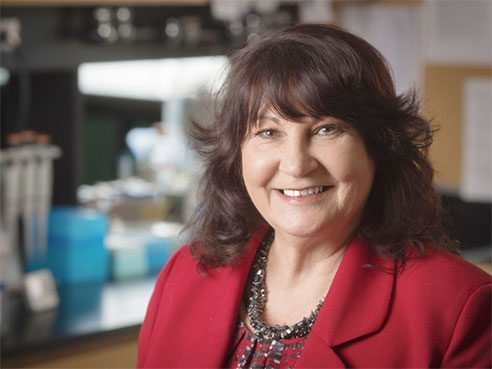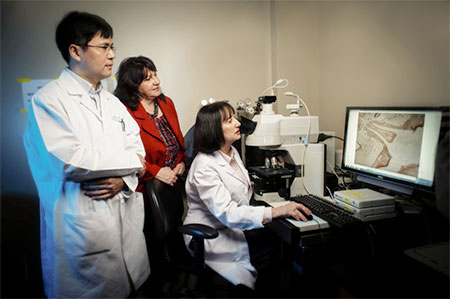 Mary MacDougallAn international group co-led by University of Alabama at Birmingham researcher Mary MacDougall, Ph.D., has unraveled the molecular basis for the rare, inherited genetic disorder, Singleton-Merten Syndrome (SMS). Individuals with SMS develop extreme, life-threatening calcification of the aorta and heart valves, early-onset periodontitis and root resorption of the teeth, decreases in bone density, and loss of bone tissue at the tips of fingers and toes.
Mary MacDougallAn international group co-led by University of Alabama at Birmingham researcher Mary MacDougall, Ph.D., has unraveled the molecular basis for the rare, inherited genetic disorder, Singleton-Merten Syndrome (SMS). Individuals with SMS develop extreme, life-threatening calcification of the aorta and heart valves, early-onset periodontitis and root resorption of the teeth, decreases in bone density, and loss of bone tissue at the tips of fingers and toes.
The cause of SMS is a missense mutation that changes a single amino acid in the protein MDA5 from arginine to glutamine, MacDougall and colleagues are reporting today (Jan. 22) in the online version of The American Journal of Human Genetics. That change in MDA5 — which detects viral double-stranded RNA as part of the innate immunity system — causes increased induction of interferon beta. Thus SMS is recognized as an innate autoimmune disease for the first time.
“The autoimmunity finding was startling,” said MacDougall, associate dean for research, James R. Rosen Chair of Dental Research, and professor in the Department of Oral and Maxillofacial Surgery at theUAB School of Dentistry, and director of UAB’s Global Center for Craniofacial, Oral and Dental Disorders. She and Frank Rutsch, M.D., Department of General Pediatrics, Muenster University Children’s Hospital, Germany, are co-first authors of the paper, “A Specific IFIH1 Gain-of-function Mutation Causes Singleton-Merten Syndrome.
Because of the unusual dental problems in SMS patients, Rutsch had contacted MacDougall 10 years ago to probe the molecular mechanisms of the syndrome. MacDougall is an internationally respected research leader in craniofacial developmental biology and dental genetics, particularly the molecular basis and mechanisms associated with human dental genetic disorders that alter tooth number, formation and hard tissue structure. Such investigations of differentiation during tooth and bone formation have broad applications across medical research.
SMS is an autosomal-dominant disorder, meaning the mutation is not carried on the sex chromosomes, and a single copy of the mutation in the gene IFIH1 that encodes MDA5 can cause disease. Rutsch identified three SMS-affected families, and researchers in Cologne, Germany performed whole-exome DNA sequencing and targeted Sanger sequencing to identify the mutation. The same mutation was found in 10 different patients.
MacDougall’s group at UAB analyzed the dental features of patients and created cell lines from SMS individuals and controls. Several of the dental pulp cell lines came from an extracted, forming third-molar that was shipped from Germany to Alabama by FedEx.
 From left: Changming Lu, Mary MacDougall and Olga MamaevaFunctional studies by the UAB group found that:
From left: Changming Lu, Mary MacDougall and Olga MamaevaFunctional studies by the UAB group found that:
- MDA5 — as measured by immunohistochemistry of human heart, skin and cartilage tissue, or demineralized developing mouse teeth — was present in all target tissues that are altered in SMS.
- Presence of the SMS- IFIH1 mutant gene increased interferon beta gene expression by 20-fold, and correcting the single mutation of the SMS-IFIH1 back to normal reduced expression to control levels.
- The SMS- IFIH1 mutant gene had a greater response, as measured by interferon beta induction, when challenged with double-stranded RNA, as compared with the normal gene.
- Whole blood of SMS individuals and the cell lines developed from the SMS tooth had higher expression of interferon signature genes, compared with control individuals and cells.
Thus, the altered gene is a gain-of-function mutation. Recently, IFIH1 has been linked to several autoimmune disorders, including Aicardi-Goutieres syndrome, though those individuals show brain and developmental defects.
The UAB research team included Changming Lu and Olga Mamaeva, research associates for the Institute of Oral Health Research in the UAB School of Dentistry, and Heidi Erlandsen, a former dental school instructor.
MacDougall is continuing SMS gene research at UAB, including probing the impact of its dysregulation of 30 genes that are involved in tooth formation and dentin mineralization; using it as a paradigm for patients with other diseases, such as periodontitis and aggressive periodontitis; screening glaucoma patients for the mutation, since early-onset glaucoma is one phenotype seen in some SMS individuals; and looking for altered microbiomes and oral biomes in SMS individuals.
The Global Center for Craniofacial, Oral and Dental Disorders at UAB, in conjunction with Dr. John Grant III, M.D., the James C. Lee III Chair in Pediatric Plastic Surgery at Children’s Hospital of Alabama, does basic, translational and clinical research to help treat and diagnose craniofacial, oral and dental disorders, and develop novel therapeutics and gene discovery for those disorders. Craniofacial and dental defects account for the majority of birth defects in the U.S., with one affected child born each hour. Grant is also Professor of Surgery at UAB and Director of the UAB Cleft and Craniofacial Center.